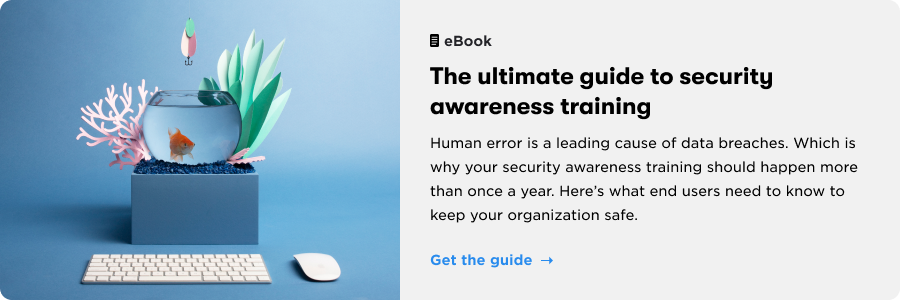A recent phishing scam targeting Office 365 users is the latest in a growing number of well-disguised cyberattacks. This particular scam added to its authenticity by using a fake Google reCAPTCHA system and real company logos.
With phishing scams becoming increasingly frequent and harder to detect, it’s time to implement an up-to-date phishing awareness training program in your organization.
What is phishing awareness training?
Phishing awareness training is a professionally designed learning program that educates employees on how to spot and report suspected phishing attempts. Arming employees with knowledge of what to look out for and how their choices affect security helps them protect themselves and the company from cybercriminals.
Because phishing is just one of the many threats organizations face, phishing awareness should be one part of a broader, more comprehensive security awareness training strategy.
To effectively deter cyber threats, employees need a well-rounded view of security. It’s not enough to just learn the different types of malware—employees need to understand how the malware gets into the system, how each of these threats affect the business, and what they can do to prevent it.
Top 3 things employees need to know about phishing awareness training
If we’re being honest, talk of any sort of “awareness training” is likely met with half-stifled groans and probably a few eye rolls. Being transparent about why this training is important and how it empowers employees to be part of the solution is critical to getting buy-in (and fewer eye rolls).
These are the 3 core messages employees need to hear:
1. It’s an ongoing process
Phishing scams are constantly evolving, so it’s not enough to sit down once a year for a quick cybersecurity recap. Staying on top of these moving targets requires frequent, in-depth training sessions to keep employees up to date on the most current phishing campaigns and tactics.
It’s also important to recognize that today’s weaknesses aren’t always tomorrow’s weaknesses. An employee who doesn’t recognize a particular phishing attempt one month might be aware of it the next, so phishing awareness training is customized to meet you where you are right now.
Another reason to conduct training sessions regularly is that repetition leads to retention. New information only sticks in the memory for so long before it becomes harder to recall, so frequent refreshers are important.
However, there is a caveat: Training content needs to be kept fresh and engaging or repetition leads to extreme boredom. And bored employees don’t retain information.
2. It’s helpful to the IT team
Because so many data breaches are caused by human error, many IT teams view employees as a liability to company security. But the right training can reverse that perception.
In reality, everyone in the company has a role to play in security, but they may just not know what it is. Phishing awareness training makes employees the first line of defense against cyberattacks and a much-needed extension of IT.
In addition to a comprehensive security awareness training program, adopting these 6 cyber safety habits will help improve security and lighten the load for IT:
- Protect your documents in the cloud
- Secure your device
- Collaborate safely with colleagues
- Follow security best practices, like using multi-factor authentication
- Secure your communication method
- Become proactive and security aware
3. It’s not personal
Phishing awareness assessments aren’t meant to embarrass or punish users. If you’ve partnered with the right training provider, mistakes are handled with humor and compassion—not humiliation—to encourage employees to keep learning and improving.
Being receptive to the training program benefits the entire organization, and using negative feedback instead of encouragement only leads to anger and an unwillingness to fully engage.
How BrainStorm can help
BrainStorm Threat Defense is an effective and engaging program that will give your team members the knowledge they need to avoid phishing scams and other cyberattacks and empower them to work more securely.
This 4-step security awareness training program focuses on understanding what threats are out there, teaching users how not to be a victim, assessing awareness of threats in a real-world setting, and remediating as needed to arm employees with the security knowledge they need.
The threat landscape is rapidly growing and changing, and organizations have to step up and fight back. Knowledge is power when it comes to cyber security, and a comprehensive security and phishing awareness training program is a highly effective defense against evolving cyberthreats.
To learn more ways to protect your organization, download The Ultimate Guide to Security Awareness Training for the latest tips, techniques, and best practices.



